Mike Vardy's Blog, page 75
March 3, 2016
When Are You REALLY Most Productive?
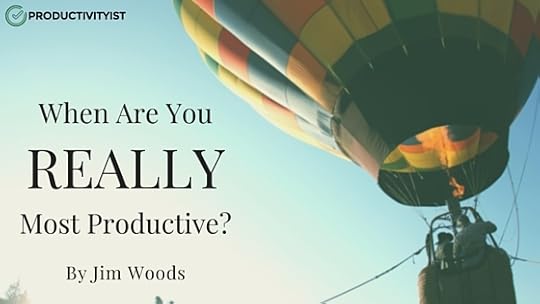
Not all hours in the day are created equal. When you first wake up—especially if you’re a night owl—you’re probably a bit groggy (and desperately in need of coffee). Or maybe you’re an early riser, so for you it’s the hour or two you spend watching TV before bed. You just know your brain is tired, so it’s not a good time to make any difficult decisions or to dive into any important work.
On the other end of the spectrum, there are times during the day when you just know you are alert and your brain is firing on all cylinders. When you do your work, you feel momentum and you’re able to see the light at the end of the tunnel.
This time period when you are most productive is something I like to call Prime Time. During this period, it is essential to do your most important work. (Cal Newport refers to this as Deep Work in this summary here.) It’s kind of surprising if you just look at the numbers, but in most cases, one hour of work during Prime Time is often better than four hours of work when you’re fatigued.
For every hour you’re awake, your body’s internal drive craves more sleep. Your body’s natural rhythm, which is called the circadian biological clock, tells you how tired you are. If you are sleep deprived, you crave sleep much more. The hours between 2-4 a.m. and 2-4 p.m. are when people are most tired, so most likely these are not your Prime Time hours.
Figure out when you work best, and then do what is most important to you. Not sure when this time is? Ask yourself these questions:
1.When do you feel best?
Another way to look at this is when do you feel most alert? When do things just seem to come more naturally to you?
2.When can you find some uninterrupted silence?
Silence is very helpful for you to do your best work. While music can be beneficial at times, there will be times that it is a distraction. Minimizing distraction leads to more focus and clarity—especially during Prime Time.
3.When are you less likely to make excuses?
In some cases, making excuses and procrastinating can be a sign that you are mentally drained. Perhaps your body is trying to tell you something.
If you’d like to when you are most productive, ask yourself these three questions and write the answers down in your journal for a week or so. Then you have some documentation to guide you instead of just guessing. I’ve concluded that my Prime Time is from 10 a.m to 2 p.m. Does that mean I only work then? No. It just means I section out my day to focus on the most important work during those hours.
In many cases, the ideal time to do your best work is one to two hours after waking up. Protect this time with boundaries and use it to your advantage. Do whatever it takes to stay on target. Set an alarm. Write down the specific task you are working on and put it on a sticky note on your computer screen. Don’t take phone calls, answer email or texts during this time. Keep your boundaries in place. Don’t break them until your alarm sounds to tell you that Prime Time is over.
When do you think you are most productive? Are you more of an early riser or a night owl? Please share in the comments below.
The post When Are You REALLY Most Productive? appeared first on Productivityist.

March 1, 2016
How to Beat Task Paralysis

At some point, each of us faces a wall that stops us from moving forward. You don’t know why the wall is there, and you’re not sure to get around it. It’s frustrating. You stare at your list of tasks and find yourself frozen in place. You’re stuck in what I call “task paralysis” – and it’s not a fun place to be.
Task paralysis is often brought on by one of three things:
You have a list of tasks is so long that it is overwhelming.
You have things on your list that aren’t tasks at all.
You’ve misaligned your tasks so that you can’t move forward with them.
Here’s how you can deal with each one of these and move forward instead of going nowhere.
1. The Overwhelmingly Long List
Take a good look at your list. Spend some time with it and sort the tasks by theme. You can group them however you would like. If you have several tasks that involve writing, you can group those together with a writing theme. If you find that some of the tasks involve content creation, you use that theme to sort those task. Once you have grouped the items by theme, it is helpful to list out your tasks by number of importance. Then, take the remaining tasks and ask yourself if they really need to be done today, done by you, or even done at all.
Once you know the most important tasks, focus your attention on those. One way I’ve done this is to narrow the tasks down to My Three Absolutes. These are three tasks that you absolutely want to accomplish during the day. Each night before I go to bed, I leave myself a note with My Three Absolutes and place it on my laptop for the next morning. That way I know what are the three things I must accomplish. This provides greater levels of clarity and focus.
Another tool that helps me move forward is the Daily MAP. What’s the Daily MAP? Well, it is a tool that can be used to help guide your day. You can work by mode, project or even schedule. Here’s a brief look at it. First, you move your tasks that you are doing today into the Action column. Then you work by either mode, project or schedule.
2. Items Mistakenly Identified As Tasks
Take a good look at your list. Look at each item on the list and ask yourself if the item requires multiple steps to complete. For example, “Clean Kitchen” is an item that requires more than one step to complete. There are several areas within the kitchen that would need to be cleaned (sweep the floor, clean the fridge, take out the garbage, etc.). Having this many tasks involved means this really is a project. You could even have a Cleaning Mode where the project could be called Clean House. Another example would be if you had Prepare Taxes as a task. This is a really project made up of several different tasks. Gathering necessary documentation, calling your accountant, signing the returns, etc. While these are simple examples, keep in mind that clarity is a huge ally when it comes to being productive. Keeping things simple and using tools like the Daily MAP can make all the difference for you when you are faced with task paralysis.
3. Wrong Place, Wrong Time
Take a good look at your list. (Are you sensing a pattern here?) The schedule column is another good way to keep track of your priorities. If you have a meeting or something that has to happen at a specific time, on the Schedule portion of the Daily MAP this is where you would put it. In some cases, you may have a task that is dependent on the completion of something else. In this case, it is essential to focus on what you can do right now. Make this work your priority. Think about your phone for a second. When you fly on a plane, you put your phone into Airplane Mode, right? No other option fits well. Choosing the right mode—which could be schedule based or even project based is essential for your success. The NOW Year™ Method is flexible in that you are the one that makes the decision. No one else can choose how you work.
Task paralysis isn’t permanent. It can be overcome with a thoughtful approach to the tasks you have to deal with – whether you’re stuck on them or otherwise. When you have many priorities, you have no priority. If you feel stuck right now, the key is to decide what your 3 Absolutes are. Once these are in place, you’ll be able to go forward rather than go off madly in all directions – or in the case of task paralysis – go nowhere at all.
We’re working on something big that will help people adopt and adapt The NOW Year™ Method to work for them. If you want to learn more about the development of this simpler, flexible, and durable productivity approach then sign up to receive The Productivityist Weekly, a newsletter written by yours truly that gets delivered to your inbox every week. I’ll be detailing further elements of The NOW Year™ Method on a regular basis in this newsletter…and subscribers will be the first to hear about what we’ve got in store for you in the very near future. Click here to subscribe to The Productivityist Weekly now!
The post How to Beat Task Paralysis appeared first on Productivityist.

February 29, 2016
The Productivityist Podcast: Getting Reading Done with Mike Dariano
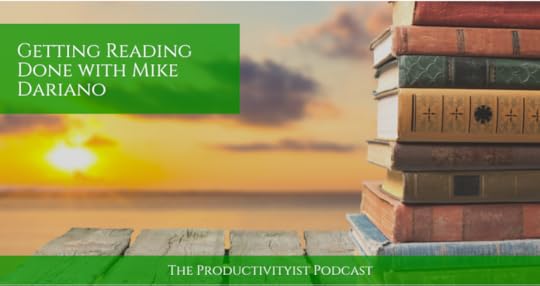
On this episode of the show, I’m joined by Productivityist’s resident book reviewer and fellow avid reader Mike Dariano. We talk about how we go about reading and what we do differently to keep our reading workflow…flowing.
The goal of this episode is to inspire you to find a way to read more without overwhelming you in the process. I hope it does the trick!
Relevant Links
Mike Dariano at Productivityist
A Mindful Conversation with Patrick Rhone | The Productivityist Podcast
Antifragile: Things That Gain from Disorder (Incerto) by Nassim Nicholas Taleb | Amazon
Quiet: The Power of Introverts in a World That Can’t Stop Talking by Susan Cain | Amazon
Audible.com
Blinkist
Thinking, Fast and Slow by Daniel Kahneman | Amazon
The Score Takes Care of Itself: My Philosophy of Leadership by Bill Walsh, Steve Jamison, Craig Walsh | Amazon
Originals: How Non-Conformists Move the World by Adam Grant | Amazon
The Practicing Mind: Developing Focus and Discipline in Your Life Master Any Skill or Challenge by Learning to Love the Process by Thomas M. Sterner | Amazon
Give and Take: Why Helping Others Drives Our Success by Adam Grant | Amazon
Patrick O’Shaughnessy | Book Club
Foolproof: Why Safety Can Be Dangerous and How Danger Makes Us Safe by Greg Ip | Amazon
The Millionaire Messenger: Make a Difference and a Fortune Sharing Your Advice by Brendon Burchard | Amazon
Born for This: How to Find the Work You Were Meant to Do by Chris Guillebeau | Amazon
The 106 Year Old Problem | Productivityist
John Allen Paulos | Amazon
mikedariano (@mikedariano) | Twitter
Thanks again for listening to the show – and if you have any feedback you can leave a comment below and/or rate and review the podcast in iTunes or whatever service you’re using to subscribe to the show. Not a subscriber yet? Click here to make that happen in iTunes and click here to grab the RSS feed!
Want to help the show even more? Then become a patron The Productivityist Podcast through our Patreon campaign! Check out The Productivityist Podcast’s Patreon page and take a look at all of the perks – including a select number of monthly Productivityist Coaching sessions with yours truly – available only to Patreon supporters!
The post The Productivityist Podcast: Getting Reading Done with Mike Dariano appeared first on Productivityist.

February 25, 2016
How To Be More Creative (And More Productive)
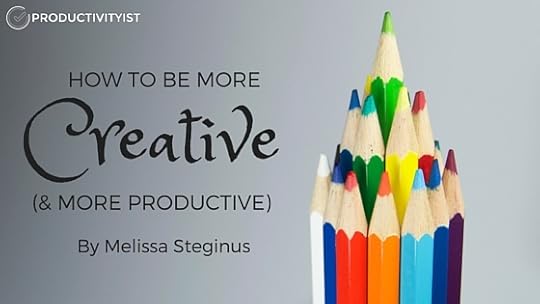
“Insanity is doing the same thing over and over again but expecting different results.” – Albert Einstein
I’ll be the first to admit that I’ve been guilty of expecting change without instigating it. According to Einstein, I have suffered insanity (which is perhaps a fair diagnosis given the frustration that arises when expectations don’t lead to action). However, I came to an important conclusion: unintentional “doing” not only wastes time and energy, it also destroys productivity and progress.
So I’ve decided to leave mindless “doing” behind for good. Instead, I’m taking a new, creative approach. And, let me tell you, I should have done this ages ago.
What is my “creative approach” exactly? It’s quite simple: I prioritize practicing creativity (it is, after all, one of my themes for 2016). Instead of tolerating the seemingly constant hurricane of thoughts and ideas in my head, I’ve decided to do something with them. Intentionally.
Here’s the creative breakdown.
First off, there are four key elements in maximizing (or, at the very least, allowing for) creativity:
Space
This encompasses both physical and mental space. Does an extensive to do list prevent you from expanding on your ideas? Do scattered files and folders menacingly glare at you from your desk? Are you constantly distracted by coworkers, children, social media, or busy work? These things may seem small on their own, but clutter and distraction can stand in your way with a Gandalf-like presence and tenacity shouting, “You shall not pass!”
Let’s avoid that. Close your web browser (in all of its tabbed browsing glory) or maybe even ditch your computer altogether. It’s time for silence. Silence allows you to stop consuming others’ ideas and start thinking about and acting on your own.
Time
Space without time may help in scribbling ideas onto paper, but it doesn’t allow you to elaborate on those ideas. Of course, elaboration is crucial in adding depth and originality to an idea. You need time to sit and peel the layers off your creative onion (a delicate and often messy process but hopefully one with less tears than caused by a literal onion).
Here’s another analogy to consider: creativity is a muscle that needs consistent exercise in order to grow. It is, in fact, a practice, not a life hack (I’m sorry to say). And practice takes time.
Tools
Let’s say you’ve scheduled time to be creative and cleared both your mind and physical workspace. Still, as you sit down to sketch out your ideas, you find that something’s missing. Perhaps you’re not quite sure what to do or how (or where) you should begin.
First things first: clarify what it is you’re doing. If the big picture eludes you, start with your medium. Artists use paint. Musicians have notes. Writers use words. Regardless of your craft, you need to have a way to express yourself. Find the tools you need and spend time visualizing and/or sketching out a basic blueprint.
Discipline
Like physical exercise, working your creative muscle takes discipline. It’s unrealistic to wait until you’re in “the zone” before hitting the gym (or doing anything), so why wait to feel “inspired” before doing something creative? Pablo Picasso – who was a fairly creative individual – strongly emphasized the importance of discipline: “Inspiration exists, but it has to find you working.”
So what are the benefits of being creative? How can it make you more productive?
You establish your voice and strengthen your message.
In this day and age, it’s easy to get overwhelmed by the influx of information available to us. Setting aside time and space to regularly practice creativity means stepping back to find your voice to clarify and solidify your message. This focus allows you to expand on your original ideas and to contribute something to the global discussion that is truly your own.
You worry less about making mistakes.
Worry is a known productivity killer. It causes stress and mental fatigue and prevents you from creating great work. But when you change your attitude to one of experimentation, you’re far more likely to find success. In the words of Tony Robbins, “There is no such thing as failure. There are only results.” Being creative means being open to exploring options and alternatives to find what works (and what doesn’t).
You become comfortable with change.
Authors often rewrite the same book, chapter, scene, etc. from different perspectives. Artists might paint a certain image using different mediums. Change and exploration allow you to figure out what works for you, what you do well (or what you need to delegate to someone who can do it better), what your message is, and how to best communicate with your audience. Finding what works may feel like a bit like a scavenger hunt, but practicing creativity will make you more comfortable with sifting through dirt to find your gold.
You feel more present.
Remember Einstein’s definition of insanity? It is unintentional repetition with the expectation of change. A creative approach emphasizes mindfulness through doing one task at a time. You cannot draw a mindmap while Tweeting or browse Facebook while writing in a journal. It’s physically (and mentally) impossible. Through removing distraction and doing the work at hand, you focus your attention on your intention.
You follow through.
Sometimes you have a great idea that you just need to put into action. You’re not quite sure how to do it. This is completely normal. Developing and practicing a creative approach requires constantly taking leaps, hitting the ground running, and building on momentum. This creates a snowball effect that will roll into other aspects of your work and life. It will give you a surge of confidence to see your projects through – from their preliminary stages through development and to completion.
So Here’s How to Be More Creative Today…
Beer before coffee. Okay, not literally. Have you ever heard that beer promotes creative idea generation whereas coffee helps you to buckle down and do the work to actualize those ideas? What I’m saying is to take time for creative idea generation and exploration before you shift into buckle-down-and-get-things-done mode. You might find that both your content and work ethic become more innovative and efficient (unless you take this advice literally… which I cannot officially condone).
Establish a mindful routine. Create space and time for yourself. Don’t let checking email or social media be your first activity of the day – instead check (in with) yourself. When I started making it a priority to meditate for 5-10 minutes before turning on my laptop each morning, I came to a startling realization: when the world is quiet, the mind is loud. I had tons of thoughts and ideas whirring around my head that I hadn’t acknowledged because I hadn’t given them the time of day (which is likely why they kept turning up at night as I attempted to fall asleep). A mindful morning routine can provide clarity and far more focus than your morning cup of coffee.
Try free writing. Choose a topic of interest or find an intriguing writing prompt and write for a certain amount of time or number of words. Don’t edit as you go. Just write freely and unfiltered. See what ideas, thought patterns, and tones pop up. The more bizarre your prompt, the more you might learn. (I once faced a few self-realizations when writing about myself from a turtle’s perspective!)
Create small challenges with practical deadlines. It’s no doubt writing a 30,000-word ebook might seem intimidating if you struggle with 500-word blog posts or stories. Start small, gain confidence, and build up. If you have a large-scale project in mind, break it down into small challenges.
Learn something completely new. This doesn’t mean jumping onto Google and reading extensively on the first topic that catches your eye. Instead, think of something that interests you – preferably unrelated to your job or day-to-day routine – and expand your knowledge on that. On the theme of Einstein quotes, he once said, “I have no special talents. I am only passionately curious.” Take your curiosity and run with it.
Collaborate with others. There are some seriously fascinating people out there doing and creating remarkable things. Burst your personal bubble of comfort and engage with them. Ask questions, discuss ideas, share stories, and contemplate long-term goals.
Keep a record. Use a notebook or journal to write down ideas, jot down quotes (feel free to begin with those in this post), expand on outlines, etc. Transform your creative brain juices into ink on a page. Draw lines, connect dots, cross things out, and rewrite them. This is how ideas go from thought bubbles to something tangible. Exploring what works and what doesn’t is crucial, but the process won’t amount to much if you can’t remember what you came up with.
Ready to begin? Schedule a specific time and place to explore your creative ideas. Gather whatever tools you might need and take a few minutes to clear your mind of other tasks and responsibilities. Then, with a topic in mind, write or sketch freely.
Be patient with your work and yourself at first. Continue to practice regularly and keep track of your progress. When you look back, you’ll see just how far you’ve come and how much more productive you are.
The post How To Be More Creative (And More Productive) appeared first on Productivityist.

February 23, 2016
Why I Stopped Doing GTD: Part 3
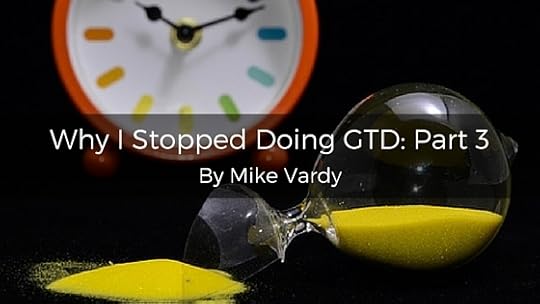
This is a piece that was originally published in The Productivityist Weekly newsletter. I wanted to share it with you on the blog as well to explain why Productivityist no longer writes or focuses on the GTD methodology. If you would like more updates, Click here and you’ll get it delivered to your inbox every week.
In the past two posts (found here and here) I’ve discussed the first two reasons why I’ve stopped using GTD. I received many emails about this topic and here are just a few examples of what was sent my way:
“I used to use GTD years ago and tried it again using THINGS when I switched from a PC to a MacBook a couple of months ago. I was driven more by the lack of Franklin Planning software for Mac and by horrific experiences with Microsoft Support for Outlook for Mac. You are spot on about GTD. I much prefer the Franklin methodology and I have reverted to using Informant and Outlook for Mac ( just the email).” – Jeff D.
“I understand where you are coming from with GTD, but I am still using a modified (think less pure) version that works for me. I am a 50-something man who (finally) got diagnosed with adult ADHD three years ago. My title is unimportant, but project manager is one of the many hats I wear. I knock the big things out of the park, it was the little things that fell through the cracks that created headaches for me at work. That’s where a system like GTD is particularly useful.” – Bob R.
“I reread the GTD book last year, bought the new paper-based guide, and listened to the GTD virtual study group. It’s just not for me either. I have used a Franklin Planner for 20 years, and it works perfectly for my needs. There are a lot of people that say it’s too business like, but as a stay-at-home mom/homeschooler it is the only thing that I found works for me.” – Cassandra S.
“I think of GTD as a set of interconnected models and evaluate it with the following questions: Are the models useful? Yes. Are they complete? Yes. Can they be simplified? I haven’t found a way to simplify them so I’m curious to see what is offered as an alternative. You still need to capture and handle inputs. You still need to plan projects. If not GTD models, then what instead?” – Jay E.
“I don’t find GTD too rigid—complex yes—but not rigid. You get to decide how many lists you should have and what should go on them. You can even have one giant next action list and one project list if that’s how you want to roll. My lists have changed over time, if I find I’m not using a context very often, I just delete it. It feels very flexible to me.” – Jason C.
“I feel like you’re putting into words the things I couldn’t quite describe when first learning GTD. I have never fully adopted GTD and instead took the ideas I liked and customized them. I feel like GTD often overthinks productivity. So as you put it, we worry more about being productive and managing the whole system instead of actually doing work that matters.” – Paul M.
“I think you’re right on point with GTD being too complicated. The core concepts are fantastic and I still apply them is a general sense; but the sheer number of lists I had (and the number of tasks on those lists) were a big reason why many things never got done.” – Ian P.
GTD can be a very polarizing as its ardent supporters can get incredibly defensive about it and those who are frustrated with it can condemn it just as easily. I’ve done neither.
I wouldn’t say I vehemently defended GTD over the years, although when I first started using it, I was incredibly evangelical about it.
As for slamming or condemning GTD, I’m not doing that either. I’ve just moved on from it… and here’s the third reason why.
It’s too fragile.
It may sound strange to say that GTD is fragile after suggesting in my previous post that it is too rigid, but hear me out. The fragility of GTD lies in the fact that it can break very easily due to its rigidity.
Think about an hourglass for a moment. It’s rigid in its ideal form. But if it was to fall from a height (likely any height), it would break apart. Once it breaks, sand starts to leak out, and it’s not getting back in there. So the only remedy is to get another hourglass… or to use another form of timer, like your mobile phone or watch.
GTD is a lot like that hourglass. Sure, you can always start over and reset yourself, but it’s often just easier to go back to the basic to do list. The problem is that the basic to do list isn’t nearly as effective as a segmented to do list.
Both the hourglass and GTD are elegant solutions. But both are too fragile to be reliable enough to stand the test of (ironically) time.
Now that I’ve outlined the three big reasons why I’ve left GTD behind, I bet you’re asking: “So if you’re not using GTD as your productivity methodology, then what are you using?”
I’ve been using a productivity approach that is simple enough to start using today. It doesn’t require any special application or notebook and is flexible enough to be used in the application – whether paper-based or digital – that you’re using right now.
This approach is flexible enough to be used by virtually anyone – whether you are a CEO, an employee looking to start their own business or side project, or a stay-at-home parent who just wants to be able to get more of the right things done every day. And it’s durable enough to not crack under the pressure and weight of everyday life, because as we all know no matter how much we plan our day very few days go according to plan.
This new approach is called The NOW Year Formula.
I have been teaching The NOW Year Formula to coaching clients for the past year and the results have been outstanding. This approach focuses on mode-based work as opposed to action or time-based work.
The NOW Year Formula allows you to connect better with the items on your to do list so you have a better chance of dealing with the things that you need to do, don’t get stuck trying to figure out what you ought to do, and ultimately get to what you want to do more frequently.
That’s what the letters in “NOW” stand for: Need to do, Ought to do, Want to do.
While I’ve stopped using GTD, I’ll always be grateful for what it has provided for me over the years. David Allen’s work has been a great help for me and I owe him a ton of gratitude for that.
But I’ve found something that works better for me. And based on what others have sent my way in response to this series (as well as what I’ve heard from my coaching clients), I know that what I’ve developed – The NOW Year Formula – will work better for others too.
To find out more, please click here to sign up for my Productivityist Weekly Newsletter. I’ve got some great surprises in store (maybe a video?) to help you simplify your life and to focus more on what is most important to you.
The post Why I Stopped Doing GTD: Part 3 appeared first on Productivityist.

February 22, 2016
The Productivityist Podcast: A Mindful Conversation with Patrick Rhone
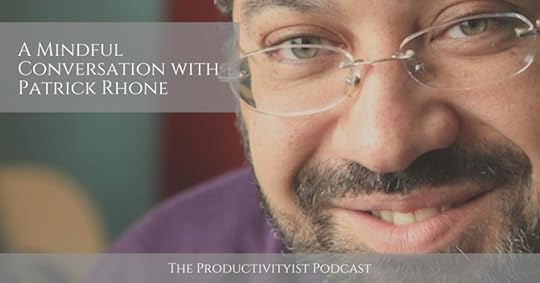
On this episode of the podcast, Patrick Rhone returns so that we can have another great conversation. This time around we focus on reading more (and better), mindfulness (and Patrick’s new book “Mindfulness for Mere Mortals), and much more.
I always have a blast talking with Patrick. I hope you enjoy the show as much as I enjoyed putting it together (with help from producer John Poelstra).
Relevant Links
PatrickRhone.com
2015 in review — 1 year after I quit blogging | Nathan Barry
Ethan Waldman at Flavors.me
10 Simple Rules for a Successful Whole30 (or any diet change) | Courtney Carver
Austin Kleon
Think Clearly.
Garrick van Buren – 612 325 9110
James Shelley · Knowledge Translation
Originals: How Non-Conformists Move the World by Adam Grant
How to Read More (and Read Better) | Productivityist
This is Water | Vimeo
Mindfulness for Mere Mortals | PatrickRhone.com
137 Books in One Year: How to Fall in Love With Reading by Kevin D. Hendricks | Amazon
The Productivityist Podcast 73: Cal Newport | Productivityist
PatrickRhone.net
patrickrhone (@patrickrhone) | Twitter
If you enjoy The Productivityist Podcast I’d appreciate a rating and review in iTunes or your podcasting platform of choice. It helps people find the show easier and will help me make improvements on the show by seeing what you have to say.
Want to help the show even more? Then become a patron The Productivityist Podcast through our Patreon campaign! Check out The Productivityist Podcast’s Patreon page and take a look at all of the perks – including a select number of monthly Productivityist Coaching sessions with yours truly – available only to Patreon supporters!
The post The Productivityist Podcast: A Mindful Conversation with Patrick Rhone appeared first on Productivityist.

February 18, 2016
Why Theming My Days has Made Me a Better Dad
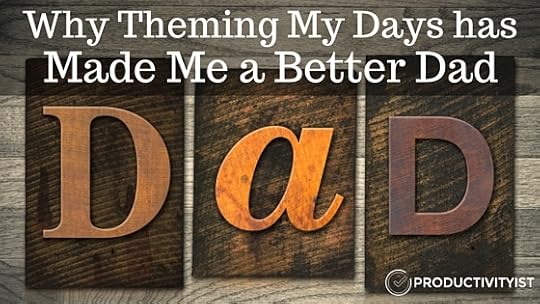
One of the reasons I do what I do is to have the freedom to spend more time with my kids. I work from home, so I either say goodbye to them as they leave for school or I walk with them to school. On three days of the week when they come home, I’m the only parent there as my wife works on those days.
Before establishing my rule of ending my workday at 2:30 pm on those days, I’d let them do their thing when they got home while I did mine. Then I realized I was giving away some of the freedom I have by not spending time with them on those days. And that’s why I put that rule in place.
Before I created that rule for myself, I had been using The NOW Year™ Method element of theming my days. (Want to know more about theming? Click here to read a more specific description of the theming process.) This approach works terrifically for me. In fact, I’d say that whether you work from home or not, theming your days can go a long way to making any father a better one. Best of all, it isn’t hard to do.
Here are three things I’ve noticed since theming my days that have played a role in making me a better dad.
1. I spend less time analyzing my tasks
Prior to theming my days – which gives them an overarching focus – I would dig into my to do list to see what needed doing. I would work by project or mode (and when necessary, schedule). As a result, each day had a lot of tasks to go over. Once I started adding daily theming to the mix, the tasks that were associated with those themes gradually aligned with the corresponding day of the week.
Now I simply look at my task app. Knowing what the day “means” to me allows me to get the things I need and want to accomplish without seeing undetermined “ought to do” items on a to do list. As a result, I have less decision fatigue and even have more energy when I spend time with my kids.
2. I wake up (and go to bed) with certainty
I wrap up every day by deciding on My 3 Absolutes for the next day and they are now associated with the theme of the next day every single time. This helps me go to bed with fewer (if any) thoughts racing through my head when it hits the pillow in the wee hours of the morning (usually around 1 a.m.).
If you’ve been reading my past work, you know I’m not a morning person. I’ve even created a small product to help people who are wired like me in this area. One of the benefits of earmarking each day of the week with a theme is that when I wake up in the morning (around 8 a.m.) I may not know what I need or want to do in detail, but I know what day of the week it is. Since I assign each day a theme, my mind automatically knows what the overarching focus for the day is with absolute certainty.
This provides me with an increased level of focus for the day ahead and allows me to move forward with purpose and precision. I waste less time figuring out what lies ahead, and it allows me to get straight to work and be present for my family when the workday comes to a close.
3. I’ve simplified my days
In my experience, the simpler things are, the easier they are to comprehend. That doesn’t mean they’re easy to do; simple and easy hold very different meanings in my book. But if you can simplify things (such as processes) then things can get easier over time. And I’ve found that to be the case because of how I’ve themed my days.
I’m not wasting as much energy going through my day because I’ve categorized it with a specific focus and then I bookend the day with my morning and evening routines. The only part of the day that is essentially “different” is the middle. The themes minimize that by pulling me towards an overarching focus instead of bouncing all over the place.
All of this means I can deal with day more effectively and efficiently. I can also spend more time with my kids before, after, and (when appropriate) during the workday.
There are other benefits to this theming process that have helped make me a better dad (and parent) such as teaching my kids about how powerful rituals can be. Theming allows me to shape my year and my business in a way that matches the school year. I didn’t start theming my days (and months) with the intent of bettering myself as a father, but it somehow worked out that way.
And I’m happy that it did.
Even if you can’t theme your days according to day of the week, there are other ways to incorporate theming into your workflow. I’ve helped a number of Productivityist Coaching Plus clients with this by going through their calendar and aligning static themes with their dynamic lives. If you want to learn from me directly how you can radically alter your life through the power of theming, then check out my Productivityist Coaching Plus program. I only take on 10 clients in this six-week program, so claim your spot today!
The post Why Theming My Days has Made Me a Better Dad appeared first on Productivityist.

February 16, 2016
Why I Stopped Doing GTD: Part 2
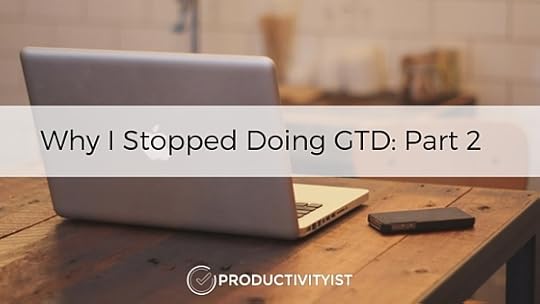
This is a piece that was originally published in The Productivityist Weekly newsletter. I wanted to share it with you on the blog as well to explain why Productivityist no longer writes or focuses on the GTD methodology. If you would like more updates, Click here and you’ll get it delivered to your inbox every week.
In my previous post, I began a three-part series on why I’ve left GTD – David Allen’s popular Getting Things Done methodology – behind. Before I get into the second reason as to why I am leaving the popular productivity methodology, I wanted to share one of the big things I took away from all of the correspondence I received as a result from the first post.
Here it is: People are really passionate about GTD.
In fact, “passionate” might even be an understatement. I’ll echo what John Saddington said in the comments of this piece called I Don’t Have Any GTD:
“…the truth is that GTD has become more than just an approach – people have elevated it to a philosophy, even a world view.”
I received more email from the first post in this series than I have with any other. So much so that I’m still responding to people about it! The emails ranged from those who totally got my reasoning to those who didn’t. I also received a lot of email outlining what people found most helpful about GTD and what they struggled with, which was great to hear.
While GTD may not be as simple as I (and others) would like it to be, there are two other reasons why I’ve shifted away from it. I’ll get to the third reason in the final part of this series, but right now I’d like to dive into the second reason.
It’s too rigid.
I’ve read numerous articles stating that GTD isn’t too rigid, but I think that in some ways it is. Creatives have said that the system is too rigid for their tastes and a number of creative types have made GTD work for them. So while I believe that there is more to GTD’s rigidity than meets the eye, it often gets buried behind the idea that GTD will work because it’s an approach that can work for almost anyone.
And frankly, that’s an issue for a lot of people who are simply adopting GTD to try to get more of what they want done.
GTD is quite involved when you first start using it, and it remains involved even after practicing it for years. Why? Because it isn’t an approach as we are used to as human beings. GTD is almost too systematic for its own good, but promises that you will accomplish more and be more productive. In many cases, GTD does in fact deliver the goods in the long term. But in some cases, for some people, it does not. Turns out I’m one of those people.
I’ve spent a considerable amount of time setting up my productivity framework with GTD at the center of it, and this was not a simple process.
GTD definitely has elements that don’t offer as much flexibility as one might need. Sure, there are different areas you can use to view your work (contexts, horizons of focus, next actions,etc.), but it still feels as if project-based work is at its center. Even with the Weekly Review, this seems a bit too regimented for my tastes. I know from experience that the Weekly Review can become something that is done less frequently, despite the fact that David Allen himself has said, “If you are not doing a Weekly Review, you are not doing GTD.” When someone recognizes that, then they start to drop other elements of the methodology (consistent capture, looking at the higher levels of the Horizons of Focus, Working with contexts, etc.) until only remnants of GTD remain. And the Horizons of Focus are key aspects of GTD – they are supposed to be the reason we keep lists in the first place, really – but many who adopt GTD have a hard time climbing above 20,000 feet and never fully realize what they’d ultimately like to achieve because of the way the other horizons appear to them.
I want to use a method that helps me navigate through the day in whatever way I decide. An approach that helps me plan out and navigate through my various “need to do” tasks so I can accomplish more “want to do” tasks over the long term.
While I know GTD has the potential to do this, the required maintenance and structure of the methodology makes it too rigid for me to use any longer. When any approach – not just GTD – feels too rigid, it becomes less desirable to use because it goes too far by removing individual thought processes from the approach. I want to be better connected to my tasks so that I can make better choices about them.
While an approach can help remove the human aspects that can cause drag, an approach can also go too far in the other direction when it’s too rigid for the individual. Maybe this why some creatives just can’t “do GTD.” It may not be too rigid in actuality… it just feels that way. GTD can become a burden because it does not have enough of the human element within the process. How do I know this? Because GTD gradually became a burden for me. At some point, you need to ask yourself if you are just following a system and creating lots of lists or are you actually completing the work that matters to you.
If the answer is the former, then that can (and should) be reason enough to leave the approach behind.
Now let me be clear: I believe it is because I practiced GTD for so long that I’ve been able to craft something that now works for me. Without GTD to send me on my way, I know I wouldn’t be anywhere near as effective as I am now. But I also know that I need to use an approach that has more flexibility and yet enough constraints to provide me with the systemization I need.
The approach I’ve been using for a while now is simpler for me to use regularly and is more flexible than anything I’ve used before. It also fulfills a third element I’ve been looking for – one that counteracts the third reason I’ve left GTD behind – and I’ll discuss that element in the final part of this series.
Do you find GTD too rigid, even in some small way? If so, what parts feel too constrictive? If you don’t find it to be that way, I’d love to hear why not. Just leave a comment below.
The post Why I Stopped Doing GTD: Part 2 appeared first on Productivityist.

February 15, 2016
The Productivityist Podcast: ADHD Productivity with Ryan McRae
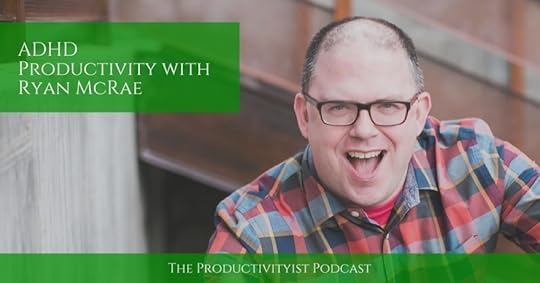
This week I speak with Ryan McRae, better known as The ADHD Nerd. We talk about how ADHD has affected his productivity, what time management tips he recommends to those who have ADHD, and how anyone should combat the perils of procrastination.
Relevant Links
The ADHD NERD
World Domination Summit
Workflowing #11: An Unfocused Look at Focus | 5by5
You’ve Just Been Diagnosed With ADHD. Now what? | The ADHD NERD
The Ultimate ADHD Guide to Time Management | Medium
The Productivityist Podcast 73: Cal Newport | Productivityist
The Ultimate ADHD Guide to Procrastination. | The ADHD NERD
Productivity Powerhouse Panel | January 27, 2016
2 Experts Share Exactly How to Use a Productivity Journal (& Increase Productivity by 23%) | The Fizzle Show
Snapchat FYI | C.C. Chapman
IFTTT
Ryan McRae on Gumroad
Ryan McRae (@TheRyanMcRae) | Twitter
A special offer from Ryan exclusive to listeners of The Productivityist Podcast
Enjoy the podcast and want to help make it even better? Then support The Productivityist Podcast by becoming a patron! Click here to visit The Productivityist Podcast’s Patreon page and choose from a wide variety of perks – including monthly 20 minute coaching sessions with yours truly available only to Patreon supporters!
The post The Productivityist Podcast: ADHD Productivity with Ryan McRae appeared first on Productivityist.

February 11, 2016
The 106 Year Old Problem
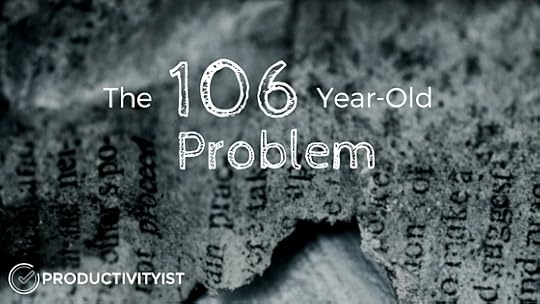
I’ve just finished reading How to Live on 24 Hours a Day by Arnold Bennett. I discovered this book through reading Cal Newport’s latest book, Deep Work. I’m surprised I hadn’t heard about this book before as it tackles the topic of time management. I can only presume that the reason it wasn’t on my radar was due to its age: it was published in 1910.
How to Live on 24 Hours a Day is a fascinating read because a lot of what Bennett discusses in it is also true in today’s world.
Time management is, at least in a documented sense, a 106 year old problem.
In one part of the book, Bennett talks about wasted time through the reading of newspapers on the train during the morning commute. Today you could replace “newspapers” with social media. He doesn’t suggest to his readers that they don’t read newspapers – he says he reads “five English and two French dailies” as well as a number of “weeklies”. He encourages – almost demands – the reader to use that time on other things instead. Things that are more meaningful and will have more impact on the reader. Things that will that will allow the reader to get closer to “knowing thyself” or, beyond that, even just spending time thinking and working on controlling their own mind. (He doesn’t entirely get around to suggest when he reads newspapers – I couldn’t find clear evidence of that, anyway. But based on his later arguments, I believe he reads them in the evening hours instead.)
At one point, he breaks down how you can claim time back – by employing “an hour and a half every other evening in some important and consecutive cultivation of the mind.” He goes a step further, saying to only do so “thrice weekly” to start. Bennett encouraged “time chunking” and boundary-setting more than a century ago – and he makes one final suggestion:
“…allow much more than an hour and a half in which to do the work of an hour and a half. Remember the chance of accidents. Remember human nature. And give yourself, say, from 9 to 11:30 for your task of ninety minutes.”
Now this may fly in the face of Parkinson’s Law (which says that “work expands to fill the time available for its completion”), but the advice is still sound at the onset. Many people who offer productivity and time management advice still suggest it to this day. The goal is to get down to that ninety minute time block and to make sure you set aside the time to do actual work and not spend time frivolously. I love this quote from the book:
“The man who begins to go to bed forty minutes before he opens his bedroom door is bored; that is to say, he is not living.”
(There is a caveat to this, however. If you spend that forty minutes in your evening routine of setting up the next day, then that is time well spent.)
The major activity that Bennett suggests the reader undertake in the evenings is reading – but not novels. Here’s what Bennett says about that:
“The best novels involve the least strain. Now in the cultivation of the mind one of the most important factors is precisely the feeling of strain, of difficulty, of a task which one part of you is anxious to achieve and another part of you is anxious to shirk; and that feeling cannot be got in facing a novel…Therefore, though you should read novels, you should not read them in those ninety minutes.”
How to Live on 24 Hours a Day has some wonderful insights, but for many these will seem familiar. Use your time wisely. Live every moment. Don’t just exist. These were issues that existed over 100 years ago, and they still exist – despite all of our technological advances – today. They may even have worsened for some of us.
Living your life doesn’t have to be difficult. You can start small and build from there. The ideas Bennett presented over 100 years ago can still be used today. So use them. If you can’t block out 90 minutes for specific pursuits (or don’t want to, like me), then theme your days so that you have planned purpose when you get home from work.
As Bennett says,”We never shall have any more time. We have, and we have always had, all the time there is.”
Make the most of your time, every single day.
The post The 106 Year Old Problem appeared first on Productivityist.




